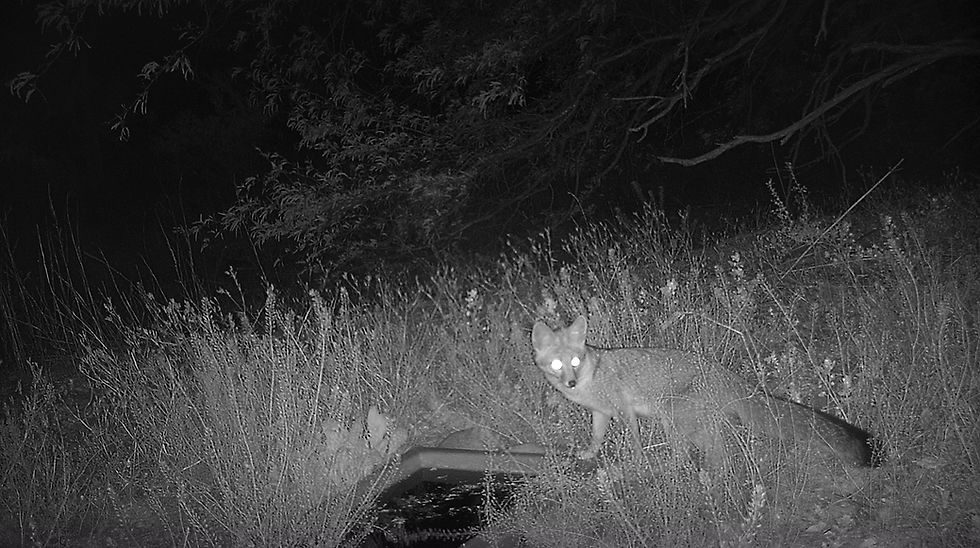Species Highlight: The Gray Fox
- Aspen Thies
- Oct 23, 2024
- 3 min read
Gray foxes (Urocyon Cinereoargenteus) are adept at navigating a variety of environments, from dense oak woodlands to sparse deserts and mountainous terrains of southern Arizona. These solitary creatures are primarily nocturnal hunters, relying on their keen senses of smell and hearing to locate prey such as rodents, rabbits, birds, and insects. Their diet occasionally includes fruits and berries as they change their foraging habits based on seasonal availability. They are known as habitat generalists and can be found throughout North and South America - the only fox to do so.
Video of two gray foxes taken at the Borderlands Wildlife Preserve.
The vast majority of our foxy photos are captured at night. A few times, they’ve darted across Highway 82 on my way into Patagonia in the early morning, but I have only seen one in person in Tucson at dusk, scampering across a trail at Catalina State Park - his tail seemed to be as long as the rest of him. Despite their elusive nature, you can catch glimpses of gray foxes darting through the underbrush like I did or perched in the branches of mesquite trees. Their ability to climb trees sets them apart from other North American canids, providing them with escape routes and vantage points to survey their surroundings.

Looking at the evolutionary tree of canines, gray foxes diverged from the last common ancestor longer than any other species of fox. Gray foxes are one of two canines (the other being the raccoon dog) known for climbing in a similar fashion to cats because they are equipped with paws that can rotate. They also have that cartoonishly long tail, another feature often seen in climbing cats that utilize it for balance. Looking into the evolutionary history of the gray fox, canines and felines shared a common ancestor at one point in time. As these two groups began to separate, Gray foxes diverged from the rest of the present-day canine species first, which is why we see features similar to those of cats since they have retained those traits once shared by the common ancestors.

To dive deeper into their evolutionary history, the gray fox's ancestors belong to a suborder called Caniformia, which includes modern-day canids (like wolves and dogs) but also other animals like bears, mustelids (skunks) and procyonids (raccoons, coatis, and ringtails). The divergence of caniforms and feliforms, including cats, dates back around 42 million years ago. Within the caniforms, the gray fox is a member of the family Canidae. Modern canids are believed to have evolved around 35-40 million years ago, and over time, different canid lineages have adapted to various ecological niches.

The gray fox belongs to the genus Urocyon, which is one of the most ancient canid lineages. This genus diverged from other canids around 10-15 million years ago, and the gray fox itself has been around in its current form for about 2-3 million years. The gray fox has some traits reminiscent of the last common ancestor of felines and canines, like its ability to climb trees, which is quite unusual among canids. This trait is reminiscent of felines, who are adept climbers. They have semi-retractable claws and a flexible limb structure that aid in climbing, echoing the climbing adaptations seen in some felines. Although the gray fox is primarily a terrestrial animal like other canids, its body structure, including the flexibility of its limbs and body, is more akin to that of some felines. Its behavior in climbing trees for safety or to access food sources has some parallels with the behavioral strategies of felines. This adaptation may have evolved to give it an advantage in its varied habitats.

While not currently listed as endangered, gray fox populations face ongoing challenges due to habitat fragmentation and human encroachment. While they are not considered ecosystem engineers or charismatic megafauna like beavers and jaguars, these mesopredators are still vital components of our landscapes. Their unique, fascinating suite of evolutionary traits has allowed them to thrive for millions of years, but they now face unprecedented threats from climate change and development. Open spaces like Borderlands Wildlife Preserve are essential for saving and connecting local habitat for critters of all sizes to thrive.






Comments